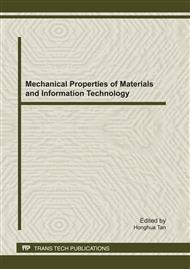[1]
Y. Jiang, et al., Application of micro-CT assessment of 3-D bone microstructure in preclinical and clinical studies, J Bone Miner Metab, vol. 23 Suppl, pp.122-31, (2005).
DOI: 10.1007/bf03026336
Google Scholar
[2]
D. Dagan, et al., Single-trabecula building block for large-scale finite element models of cancellous bone, Med Biol Eng Comput, vol. 42, pp.549-56, Jul (2004).
DOI: 10.1007/bf02350998
Google Scholar
[3]
G. H. van Lenthe, et al., Specimen-specific beam models for fast and accurate prediction of human trabecular bone mechanical properties, Bone, vol. 39, pp.1182-9, Dec (2006).
DOI: 10.1016/j.bone.2006.06.033
Google Scholar
[4]
Z. X. Wu, et al., Effect of ovariectomy on BMD, micro-architecture and biomechanics of cortical and cancellous bones in a sheep model, Med Eng Phys, vol. 30, pp.1112-8, Nov (2008).
DOI: 10.1016/j.medengphy.2008.01.007
Google Scholar
[5]
X. S. Liu, et al., Contributions of trabecular rods of various orientations in determining the elastic properties of human vertebral trabecular bone, Bone, vol. 45, pp.158-63, Aug (2009).
DOI: 10.1016/j.bone.2009.04.201
Google Scholar
[6]
H. S. Kim and S. T. Al-Hassani, A morphological model of vertebral trabecular bone, J Biomech, vol. 35, pp.1101-14, Aug (2002).
Google Scholar
[7]
E. F. Morgan, et al., Trabecular bone modulus-density relationships depend on anatomic site, J Biomech, vol. 36, pp.897-904, Jul (2003).
DOI: 10.1016/s0021-9290(03)00071-x
Google Scholar
[8]
H. J. Grote, et al., Intervertebral variation in trabecular microarchitecture throughout the normal spine in relation to age, Bone, vol. 16, pp.301-8, Mar (1995).
DOI: 10.1016/8756-3282(94)00042-5
Google Scholar
[9]
Y. N. Yeni, et al., Trabecular shear stress amplification and variability in human vertebral cancellous bone: relationship with age, gender, spine level and trabecular architecture, Bone, vol. 42, pp.591-6, Mar (2008).
DOI: 10.1016/j.bone.2007.11.011
Google Scholar
[10]
P. A. Hulme, et al., Regional variation in vertebral bone morphology and its contribution to vertebral fracture strength, Bone, vol. 41, pp.946-57, Dec (2007).
DOI: 10.1016/j.bone.2007.08.019
Google Scholar
[11]
E. Perilli, et al., Structural parameters and mechanical strength of cancellous bone in the femoral head in osteoarthritis do not depend on age, Bone, vol. 41, pp.760-8, Nov (2007).
DOI: 10.1016/j.bone.2007.07.014
Google Scholar
[12]
P. Mc Donnell, et al., Simulation of vertebral trabecular bone loss using voxel finite element analysis, J Biomech, vol. 42, pp.2789-96, Dec 11 (2009).
DOI: 10.1016/j.jbiomech.2009.07.038
Google Scholar
[13]
N. Otsu, A threshold selection method from gray-level histograms, IEEE Trans. Systems, Man, and Cybernetics, vol. 9, pp.62-66, (1979).
DOI: 10.1109/tsmc.1979.4310076
Google Scholar
[14]
W. S. Siu, et al., A study of trabecular bones in ovariectomized goats with micro-computed tomography and peripheral quantitative computed tomography, Bone, vol. 35, pp.21-6.
DOI: 10.1016/j.bone.2004.03.014
Google Scholar
[17]
500±3. 383.
Google Scholar
[4]
137±0. 372.
Google Scholar
177±0. 026* (2mm)3.
Google Scholar
[18]
120±2. 712.
Google Scholar
[3]
060±0. 380.
Google Scholar
218±0. 028* (3mm)3.
Google Scholar
[18]
700±3. 151.
Google Scholar
[2]
920±0. 277.
Google Scholar
235±0. 025* (4mm)3.
Google Scholar
[18]
780±2. 877.
Google Scholar
[2]
840±0. 264.
Google Scholar
245±0. 024* (5mm)3.
Google Scholar
[19]
130±2. 746.
Google Scholar
[2]
770±0. 266.
Google Scholar
258±0. 022 (6mm)3.
Google Scholar
[19]
673±2. 615.
Google Scholar
[2]
655±0. 264.
Google Scholar
275±0. 025 (7mm)3.
Google Scholar
[19]
965±2. 627.
Google Scholar
[2]
533±0. 149.
Google Scholar
295±0. 017 (8mm)3.
Google Scholar
[20]
090±2. 704.
Google Scholar
[2]
508±0. 131.
Google Scholar
300±0. 016 (9mm)3.
Google Scholar
[20]
115±2. 809.
Google Scholar
[2]
528±0. 144.
Google Scholar
300±0. 022 (10mm)3.
Google Scholar
[19]
950±2. 985.
Google Scholar
[2]
553±0. 134.
Google Scholar
298±0. 021 Total volume^.
Google Scholar
[20]
06±2. 822.
Google Scholar
[2]
518±0. 136.
Google Scholar
299±0. 019 *P<0. 05 for comparison to the control group Values were calculated using the software of MicroView (Healthcare Explore Locus, GE Medical Systems, Milwaukee, USA). ^Dunnett-t test was used, where the parameters of total volume were from the control group. Table 2. Mean and SD values for the micro-architectural parameters in Cylindrical ROIs BV/TV(1) BS/BV(1/mm) Tb. Th(mm) Tb. N(1) Tb. Sp(mm) (1mm)3.
DOI: 10.7717/peerj.10036/table-4
Google Scholar
[17]
248±3. 158.
Google Scholar
[3]
598±0. 254.
Google Scholar
162±0. 023* (2mm)3.
Google Scholar
[17]
489±3. 186.
Google Scholar
[2]
878±0. 181.
Google Scholar
236±0. 022* (3mm)3.
Google Scholar
[17]
315±3. 066.
Google Scholar
[2]
734±0. 213.
Google Scholar
253±0. 021* (4mm)3.
Google Scholar
[18]
546±3. 339.
Google Scholar
[2]
755±0. 191.
Google Scholar
278±0. 020 (5mm)3.
Google Scholar
[18]
69±3. 185.
Google Scholar
[2]
740±0. 173.
Google Scholar
287±0. 019 (6mm)3.
Google Scholar
[18]
067±2. 218.
Google Scholar
[2]
673±0. 140.
Google Scholar
291±0. 019 (7mm)3.
Google Scholar
[19]
377±2. 670.
Google Scholar
[2]
615±0. 160.
Google Scholar
293±0. 019 (8mm)3.
Google Scholar
[19]
503±2. 969.
Google Scholar
[2]
602±0. 164.
Google Scholar
296±0. 018 (9mm)3.
Google Scholar
[20]
525±2. 428.
Google Scholar
[2]
520±0. 130.
Google Scholar
301±0. 018 (10mm)3.
Google Scholar
[20]
415±2. 340.
Google Scholar
[2]
481±0. 112.
Google Scholar
303±0. 018 Total volume^.
Google Scholar
[20]
06±2. 822.
Google Scholar
[2]
518±0. 136.
Google Scholar
299±0. 019 *P<0. 05 for comparison to the control group Values were calculated using the software of MicroView (Healthcare Explore Locus, GE Medical Systems, Milwaukee, USA). ^Dunnett-t test was used, where the parameters of total volume were from the control group. Figure. 1 The different shape of ROIs. Figure. 2 Architectural parameters of different shapes with continous changing lengths.
Google Scholar


